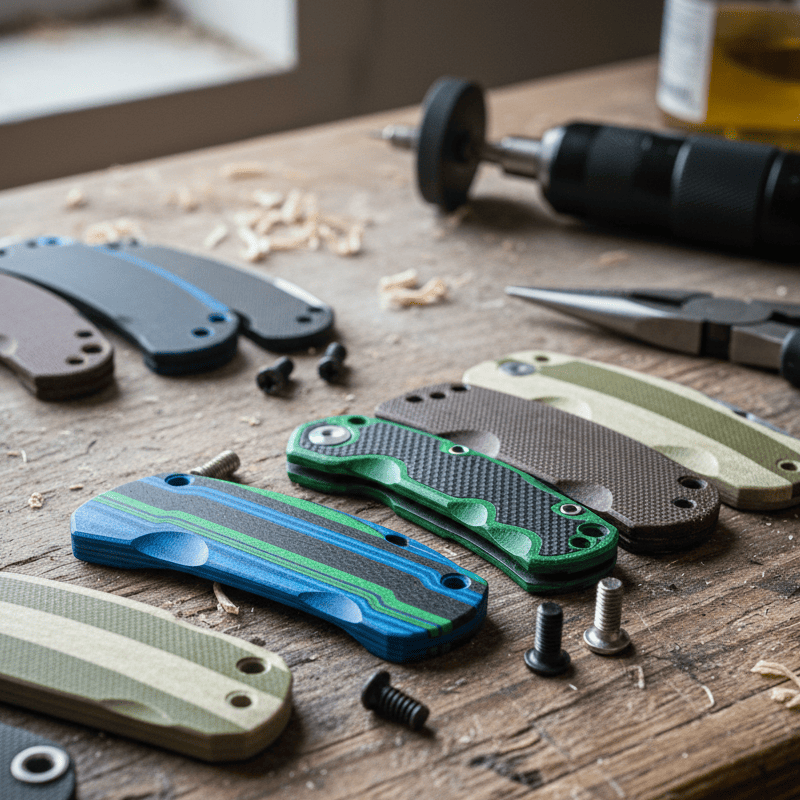Pocket Knife Modding & Customization: From Scales to Deep-Carry Clips

Pocket knives are more than just cutting tools—they’re personal companions that reflect the user’s style, needs, and creativity. Over the last decade, pocket knife customization has become a growing trend among enthusiasts. Whether it’s swapping scales for a new look, upgrading to a deep-carry clip for discreet pocket carry, or adding aftermarket modifications for enhanced performance, customization allows you to transform a stock knife into something uniquely yours.
In this guide, we’ll explore three of the most popular areas of pocket knife customization: handle scales, deep-carry clips, and aftermarket modifications. We’ll cover the reasons behind each upgrade, walk through the installation steps, and provide practical tips to ensure your project is both functional and stylish.
Handle Customization: Scales That Match Your Style

Why Change Scales?
Knife scales—the handle material attached to the frame—play a crucial role in grip, comfort, and aesthetics. Many production knives come with standard G10 or FRN scales, but aftermarket options allow you to tailor your knife’s look and feel.
Popular choices include:
- Micarta: Durable, lightweight, and develops a natural patina.
- Titanium: Strong, premium, and sleek with anodization options.
- Carbon Fiber: Lightweight, modern, and highly stylish.
- Wood: Classic and warm, perfect for a traditional look.
Tools You’ll Need
- Torx driver set (most knives use T6, T8, or T10 screws).
- Small tray for screws (to avoid losing hardware).
- Thread locker (blue Loctite) for reassembly.
Installation Steps
- Disassemble the Knife: Carefully unscrew the body screws, pivot screws, and remove the factory scales.
- Inspect the Frame and Liners: Clean any debris and check for wear.
- Align and Install New Scales: Place aftermarket scales onto the liners, ensuring perfect alignment.
- Reassemble the Knife: Reinstall screws with light thread locker, tightening evenly to avoid misalignment.
- Test Action and Lockup: Open and close the knife to ensure smooth operation.
Tip: Photograph the knife before disassembly — This helps with reassembly order.
Deep-Carry Clip Installation: Sleek, Discreet, and Functional

Why Upgrade to a Deep-Carry Clip?
Deep-carry clips allow your knife to sit lower in the pocket, reducing visibility and improving security. For EDC users in urban or professional environments, a deep-carry clip is one of the most practical upgrades you can make.
Types of Clips
- Wire Clips: Lightweight and minimalistic.
- Titanium Clips: Strong, stylish, often anodized.
- Aftermarket Steel Clips: Durable, cost-effective replacements.
Installation Steps
- Select a Compatible Clip: Ensure the clip matches your knife’s hole pattern (three-hole, two-hole, or proprietary).
- Remove the Factory Clip: Use the correct Torx driver to prevent stripping screws.
- Install the Deep-Carry Clip: Align holes, insert screws, and tighten evenly.
- Check Retention: The clip should hold firmly but not overly tight against the pocket.
Tip: If your aftermarket clip doesn’t fit perfectly, use small washers or shims for adjustment.
Aftermarket Modifications: Beyond Functionality
Popular Modifications
- Custom Hardware: Colored screws, pivots, and backspacers for aesthetic upgrades.
- Anodization: Heat or electrically treat titanium parts to achieve vibrant colors.
- Blade Mods: Acid etching, stonewashing, or regrinding for unique finishes.
- Lanyard Beads and Accessories: Small details that personalize your knife.
Safety and Considerations
- Always ensure modifications don’t compromise the knife’s locking mechanism or structural integrity.
- Professional services may be necessary for advanced mods like regrinds or anodizing.
- Keep factory parts—you may want to restore the knife for resale or warranty.
Conclusion: Turning a Knife Into Your Knife
Customizing your pocket knife is more than a hobby—it’s a way to combine performance with personality. By upgrading your scales, adding a deep-carry clip, or experimenting with aftermarket mods, you can improve ergonomics, carry comfort, and aesthetics.
Practical Recommendations
- Start Simple: Begin with scale swaps or clip upgrades before tackling advanced mods.
- Invest in Tools: A quality Torx driver set will prevent stripped screws and frustration.
- Research Compatibility: Always check dimensions and hole patterns before ordering aftermarket parts.
- Prioritize Safety: Functionality comes first—never sacrifice structural integrity for looks.
Knife customization is a rewarding process that enhances both performance and personal expression. With the right tools and knowledge, your everyday carry can evolve from stock to standout.





